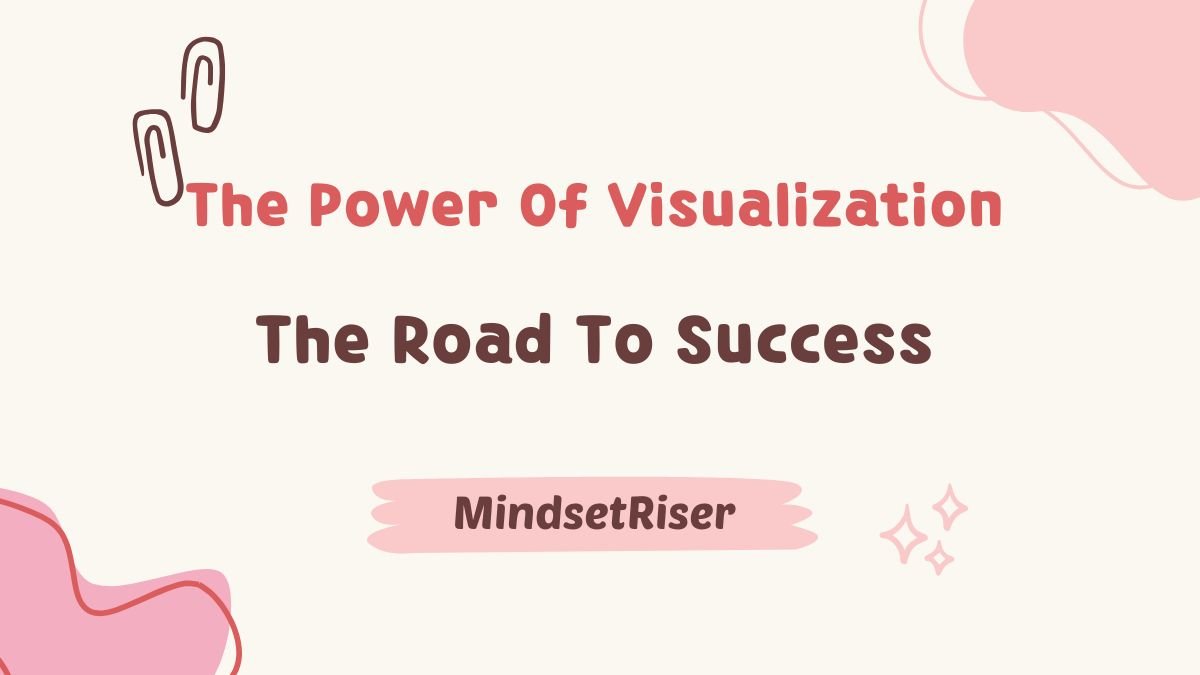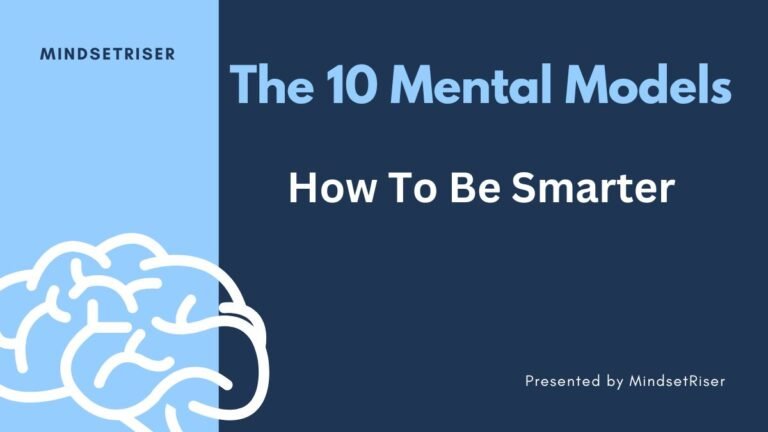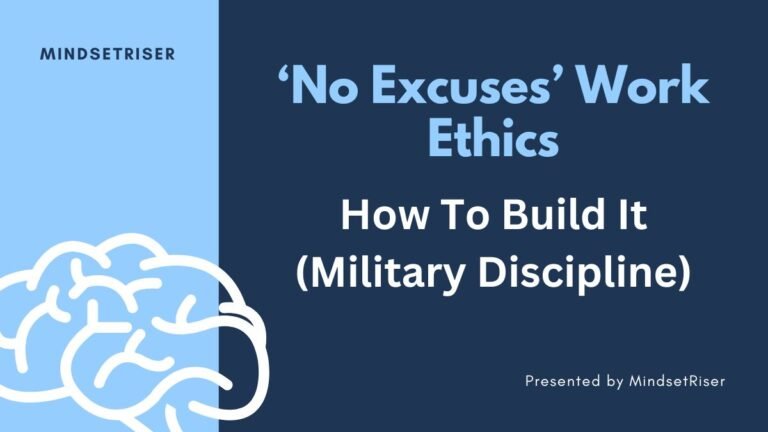Unlock Your Potential: The Power of Visualization for Success and Goal Achievement
1. Introduction: The Power of Visualization What if the key to achieving your goals is not just hard work, but also the power of your mind? Visualization is the process of mentally picturing your goals and dreams as though they’ve already been achieved. It’s a powerful tool that helps athletes, business leaders, and everyday people…
1. Introduction: The Power of Visualization
What if the key to achieving your goals is not just hard work, but also the power of your mind?
Visualization is the process of mentally picturing your goals and dreams as though they’ve already been achieved. It’s a powerful tool that helps athletes, business leaders, and everyday people unlock their potential and create a clear path to success. Whether you’re aiming to improve your performance at work, enhance your athletic skills, or simply manifest a better life, visualization can be the secret ingredient to making your dreams a reality.
In this article, we’re going to dive deep into the concept of visualization—what it is, how it works, and why it can be so powerful. You’ll learn about the science behind it, how to apply it in your daily life, and the incredible benefits it can bring to your mental and physical well-being.
2. Understanding Visualization
Visualization is more than just imagining things—it’s about creating vivid, detailed mental images that help you achieve specific goals. By engaging in this process, you’re training your brain to align with the success you want to manifest. But to truly harness the power of visualization, it’s important to understand what it is and how it works.
What is Visualization?
At its core, visualization is the act of forming mental images of a desired outcome. For example, if you’re an athlete preparing for a big race, you might visualize yourself crossing the finish line first. The more detailed and immersive you make these images, the more powerful the effect can be on your performance and mindset.
Types of Visualization
- Creative Visualization
This type of visualization is about using your imagination to create mental images of success and positive outcomes. It’s not just a passive daydream; it’s an active process where you deliberately focus on what you want to achieve. Whether it’s visualizing a successful job interview or picturing yourself achieving a personal milestone, creative visualization helps set the stage for real-world results. - Mental Rehearsal
Mental rehearsal is often used by athletes, musicians, and performers. It involves picturing yourself performing specific actions or tasks, such as executing a perfect tennis serve or delivering a flawless speech. It’s an effective way to improve skills and prepare for high-pressure situations because the brain doesn’t distinguish between a real action and a vividly imagined one.
Why Does Visualization Work?
Visualization isn’t just wishful thinking—it has a strong foundation in neuroscience. When you visualize an action, the brain activates similar neural pathways to those used when physically performing that action. This means your brain is training to improve your actual performance, making visualization a highly effective tool for improving focus, performance, and mental clarity.
3. The Science Behind Visualization
While visualization might seem like a mental exercise, its effects are supported by solid science. Understanding the neurological processes involved can help you realize just how powerful this technique is.
Neurological Insights: How Your Brain Responds to Visualization
When you vividly imagine a scenario, your brain responds almost as if it were happening in real life. This is because of neuroplasticity, which refers to the brain’s ability to reorganize and form new neural connections based on experiences, both real and imagined.
- Mirror Neurons: These neurons fire when we perform an action or when we observe someone else performing that same action. Interestingly, the same mirror neurons are activated when you visualize an action, making your brain believe you are physically doing it.
- The Brain-Body Connection: Studies have shown that when athletes visualize themselves performing at their best, the brain activates the same areas responsible for actual movement. This mental rehearsal helps improve motor skills and increases confidence.
Scientific Studies Supporting Visualization
Research on visualization has shown its positive effects across various fields, from sports to education to personal development. Here are a couple of key findings:
- Athletes: Studies have shown that athletes who visualize their performances—whether it’s a perfect dive or a successful shot—improve their actual performance. A well-known study in 1992 with basketball players demonstrated that players who visualized themselves shooting free throws improved their performance by up to 23%.
- Pain Management: Visualization has also been used in therapeutic settings. Research has shown that mental imagery can reduce pain and anxiety by helping individuals focus on something calming or by visualizing the body healing itself.
The Role of Brain Plasticity in Visualization
One of the most exciting aspects of visualization is its connection to brain plasticity—the brain’s ability to adapt and change. When you repeatedly visualize a task or goal, you strengthen the neural pathways that are related to it. Over time, this can lead to better performance, enhanced learning, and a more focused mindset.
4. Benefits of Visualization
The power of visualization goes far beyond just helping you “imagine” success. It has tangible benefits that can positively impact your performance, motivation, and mental health. Let’s explore the key benefits of incorporating visualization into your life.
1. Improved Performance
Visualization isn’t just a mental exercise—it’s a performance booster. Many successful athletes, musicians, and professionals use visualization as part of their preparation.
- Athletic Performance: Visualizing specific actions, such as a perfect basketball shot or a successful sprint, can help improve real-life performance. Your brain practices the motion and technique, even if your body is not physically doing it.
- Workplace Success: Visualization helps you mentally rehearse tasks, whether it’s giving a presentation, negotiating a deal, or navigating a tricky project. By creating a clear picture of success, you enhance your focus and readiness.
2. Enhanced Focus and Clarity
When you visualize your goals clearly and in detail, it helps sharpen your focus. It creates a roadmap for success in your mind, reducing distractions and giving you a more defined path to follow.
- Goal Clarity: Visualization allows you to articulate exactly what you want to achieve, bringing clarity to your intentions. Whether it’s a career goal, fitness target, or personal development, knowing precisely what success looks like makes it easier to take actionable steps.
- Mental Rehearsal for Decision Making: Visualizing possible outcomes helps you mentally prepare for challenges and decision-making situations. You can foresee obstacles and plan your responses, which enhances problem-solving and decision-making abilities.
3. Increased Motivation
Visualization acts as a motivational tool by giving you a glimpse of your success. When you mentally see the rewards of your efforts, it drives you to take real action.
- Fuel for Persistence: By vividly imagining the successful completion of a task or goal, you stay motivated even when faced with setbacks. It reminds you that success is possible, pushing you to continue working toward it.
- Confidence Boost: When you repeatedly visualize yourself succeeding, it strengthens your belief in your abilities. This inner confidence often leads to better outcomes, because confidence reduces self-doubt and encourages proactive behavior.
4. Stress Reduction and Mental Well-Being
One of the most overlooked benefits of visualization is its ability to reduce stress and improve mental health.
- Stress Relief: By visualizing peaceful, calm scenarios, or focusing on positive outcomes, you can help reduce the levels of stress and anxiety. Visualization allows your body to relax and focus on positive experiences, which has a direct impact on your overall mental well-being.
- Emotional Regulation: Visualization helps you stay emotionally balanced by focusing on desired outcomes rather than potential failures. This process can foster resilience, helping you stay calm in high-pressure situations.
5. Emotional and Psychological Benefits
Visualization is more than just a technique to enhance physical performance. It also plays a vital role in emotional regulation and overall psychological health.
- Positive Mindset: Regularly visualizing success can promote a positive mindset, making you more likely to approach challenges with optimism.
- Increased Self-Worth: Visualization helps in building your belief in your abilities. As you picture yourself overcoming obstacles and achieving your goals, you start to develop a stronger sense of self-worth and capability.
5. Practical Techniques for Effective Visualization
Now that we’ve covered the benefits of visualization, let’s dive into how you can start using it effectively in your own life. Here are some practical techniques to help you harness the full power of visualization:
1. Set Clear Goals
The first step in effective visualization is knowing exactly what you want to achieve. Be as specific as possible.
- SMART Goals: Use the SMART framework (Specific, Measurable, Achievable, Relevant, Time-bound) to clearly define your goals. The more specific your goal, the more powerful your visualization process will be.
- Focus on One Goal at a Time: While it’s tempting to visualize multiple goals simultaneously, focusing on one goal at a time ensures that your mental imagery is vivid and powerful. This focused attention helps your brain connect with the desired outcome more effectively.
2. Use All of Your Senses
To make your visualization more powerful, try to engage all of your senses. The more sensory details you incorporate, the more real your mental image will feel.
- Sight: Imagine what success looks like. Picture the details—what are you wearing? Where are you? What is happening around you?
- Sound: Can you hear anything? The cheering of a crowd, the sound of your voice, or the rustle of paper during a presentation? Engage these auditory senses.
- Smell, Touch, Taste: These senses may seem less obvious, but adding smells or physical sensations can make your visualization even more immersive. Imagine the feeling of accomplishment or the taste of victory.
3. Create a Routine
Like any skill, visualization gets better with practice. Set aside dedicated time each day for visualization.
- Daily Practice: Set aside 5-10 minutes each day for your visualization routine. Ideally, do it in a quiet space where you can focus completely on the mental exercise.
- Consistency is Key: Make visualization a regular part of your routine, whether in the morning, before bed, or right before an important event. The more consistently you practice, the stronger the effect.
4. Visualize Success, Not Failure
The power of visualization lies in focusing on positive outcomes. Rather than worrying about what could go wrong, focus on what will go right.
- Positive Mental Imagery: Imagine yourself succeeding in vivid detail. Feel the joy, the pride, and the satisfaction of achieving your goal. The more positive and vivid the imagery, the stronger the effect on your mind and body.
- Stay Present: Avoid visualizing negative scenarios like failure or anxiety. Negative visualization can actually trigger stress, so focus only on the successful version of your journey.
5. Use Guided Visualization and Tools
If you’re just starting with visualization or need extra guidance, there are plenty of tools and resources available.
- Guided Meditation: Many apps and YouTube channels offer guided visualization meditations that help you stay on track. These guided sessions take you through the process of mentally rehearsing success and calmness.
- Visualization Apps: Apps like Calm, Headspace, or Insight Timer include visualizations for various goals—relaxation, productivity, or success-building. They can provide structure, especially if you’re new to the practice.
6. Case Studies and Real-Life Examples
One of the best ways to understand the power of visualization is to look at real-world examples. Many successful people, from athletes to entrepreneurs, have used visualization to reach their goals and achieve greatness. Let’s explore a few case studies that show how visualization has transformed lives.
1. Athletes and Visualization
Many of the world’s top athletes swear by visualization as a critical component of their training. It’s not just about practicing physical skills—mental imagery is just as important.
- Michael Phelps: The Olympic swimmer Michael Phelps is known for his use of mental rehearsal and visualization. Before each race, Phelps would visualize every stroke, every turn, and the exact feeling of touching the wall. In fact, during one of his gold-medal races, Phelps’ goggles filled with water, but his mental rehearsal was so strong that he was able to complete the race as though nothing had gone wrong.
- Serena Williams: Tennis champion Serena Williams has often spoken about how visualization helps her stay focused and mentally prepared before a match. She visualizes every shot, the trajectory of the ball, and how she wants to move on the court. This technique has helped her stay calm, focused, and in control during high-pressure matches.
2. Entrepreneurs Who Use Visualization
Entrepreneurs and business leaders also use visualization to succeed in their ventures. The ability to mentally see success helps them stay motivated, focused, and goal-driven.
- Steve Jobs: Steve Jobs, the co-founder of Apple, was known for his ability to see the future of technology in vivid detail. His creative and strategic visualization helped him build one of the most innovative companies in the world. Jobs famously envisioned groundbreaking products before they were even created, allowing his team to bring those visions to life.
- Elon Musk: Elon Musk, the CEO of Tesla and SpaceX, often uses visualization to help turn his outlandish ideas into reality. He has spoken about visualizing the engineering challenges and solutions involved in launching rockets or creating electric cars. This mental imagery helps him approach challenges with confidence and clarity.
3. Everyday People Who Used Visualization
While celebrities and high-profile figures make the headlines, visualization has also helped countless everyday people achieve personal and professional success.
- Overcoming Personal Obstacles: Many individuals have used visualization to overcome personal hurdles like fear of public speaking, low self-esteem, or a lack of motivation. By picturing themselves succeeding, they build confidence and belief in their abilities.
- Career Success: Everyday professionals have used visualization to enhance their performance at work, earn promotions, or achieve career goals. By mentally rehearsing successful interviews, projects, or presentations, they enter these situations with a stronger sense of control and purpose.
7. Common Mistakes to Avoid in Visualization
While visualization can be a powerful tool, it’s important to practice it correctly. Here are some common mistakes to avoid to ensure that your mental imagery is effective:
1. Lack of Specificity
One of the most common mistakes is being too vague about what you want to achieve. Visualization works best when you have clear, specific goals.
- Be Detailed: Instead of vaguely imagining “success,” visualize exactly what success looks like. If your goal is to give a presentation, picture the room, the audience’s reactions, your body language, and your words. The more detailed your mental picture, the stronger the impact it will have on your performance.
- Focus on the Outcome: Rather than just focusing on the process, think about the end result—what does success feel like? What emotions are you experiencing once you’ve reached your goal? Specificity helps your brain form the neural connections needed to achieve that success.
2. Not Aligning Visualization with Action
Visualization is not a substitute for hard work. Some people make the mistake of thinking that visualizing success alone will bring results, without putting in the effort required.
- Take Action: While visualization can prime your mind for success, you still need to take actionable steps toward your goals. If you visualize acing an exam, you still need to study. Visualization helps enhance your motivation and performance, but it should always be paired with action.
- Don’t Rely Solely on Mental Imagery: Use visualization as a tool to complement your efforts. Mental rehearsal can help refine your skills and boost your confidence, but the real results come when you put in the effort outside of your mental exercises.
3. Negative Visualization
While it’s natural to have some concerns or doubts, focusing too much on negative outcomes can undermine the effectiveness of visualization.
- Focus on Positive Outcomes: When you visualize, avoid picturing failure, fear, or mistakes. Instead, focus on the positive aspects—the joy of success, the feeling of achievement, or the confidence that comes with reaching your goal.
- Don’t Dwell on What Could Go Wrong: If you find yourself visualizing negative scenarios, redirect your focus to the positive. Shift your mental imagery to how you’ll handle challenges or obstacles with grace and confidence.
4. Overcomplicating the Process
Sometimes, people make the mistake of overcomplicating visualization by trying to control every detail of the process. While it’s important to be detailed, you also don’t need to overthink it.
- Keep It Simple: The key is to make your visualization process effortless and relaxing. Don’t get caught up in trying to visualize every minute detail. Focus on the big picture—how will you feel, what will you achieve, and what are the steps to get there?
- Don’t Force It: Visualization should feel natural. If you’re feeling stressed or pressured to make it work, take a step back and try again when you’re more relaxed. It’s not about perfection—it’s about connecting with your goals in a meaningful way.
8. Conclusion: Embrace the Power of Visualization
Visualization is not just a mental exercise; it’s a transformative tool that can help you unlock your potential, improve performance, and achieve your goals. By creating vivid mental images of success, you train your brain to focus on positive outcomes, increase your motivation, and perform at your best.
Key Takeaways:
- Visualization helps improve performance, boost confidence, and clarify goals.
- It’s backed by science, activating the same neural pathways as physical actions.
- Regular, detailed, and positive visualization increases your chances of success.
- Visualization should be paired with action, and focus should be on positive outcomes rather than negative scenarios.
Now that you understand the power of visualization, it’s time to put it into practice. Start by visualizing your goals every day, using all your senses to make your mental images as vivid as possible. Whether you’re aiming for career success, personal growth, or improved performance in sports, visualization can be the key to unlocking the results you desire.
Call to Action:
Try incorporating visualization into your daily routine for the next week. Picture yourself succeeding at something important to you. Pay attention to how it shifts your mindset and influences your actions. Visualization may be the most powerful tool you never knew you had!
Final Thought:
What could you achieve if you could clearly picture your success every day? Visualization is a simple yet powerful tool that could be the key to reaching your fullest potential.







